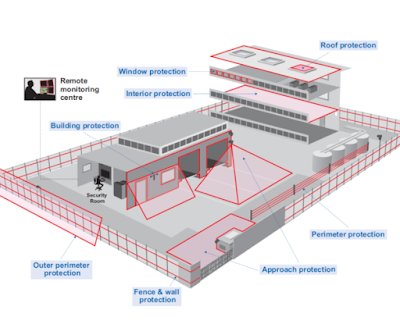What are the key applications of Infrared beam sensors?
Infrared Beam Sensor
Used for the security purposes, Infrared beam sensor is the simplest way to detect motion. These sensors use infrared rays to detect any stir or activity. Infrared rays are electromagnetic radiations having longer wavelengths. Since these wavelengths are longer than visible light, they are invisible to humans. Also, these rays tend to absorb or emit the molecules in case any changes appear in their molecular state. Infrared beam sensors are created by using this property of Infrared rays. These rays are also utilized in industrial, military, astronomy, scientific, and commercial applications.
How do these rays detect motion?
The human body's normal wavelength is 10 micrometers at room temperature, and the wavelength of infrared rays ranges from 700 nanometers to 1 micrometer which allows them to detect heat loss, blood flow, the human body's temperature, etc. Thus, any motion can be easily detected by Infrared rays used in the Infrared beam sensor.
These devices are nowadays deployed both in residential and business locations in order to assure safety. A high quality safety system will benefit you in several ways, whether you are at home or at your business. Several businesses provide infrared beam sensors such as Optex Pinnacle India Pvt. Ltd. Over the years, demand and need for these devices has grown immensely.
There are two types of infrared beam sensors in general:
1. Active Infrared sensors and
2. Passive Infrared sensors. A passive infrared sensor only detects the motion or activity and doesn't reflect it on the LED.
Active Infrared sensor
Active Infrared beam sensor emits infrared rays using a transmitter that are received by their receiver. This sensor not only detects motion but also emits radiation. Active infrared rays have three parts, i.e. receiver, transmission medium, and LED. The transmission medium is required for transmitting Infrared rays via fiber cables, vacuum, etc.
Firstly, the activity is reflected upon the LED, and then it is collected by the receiver. For this phenomenon to happen, the object should come closer to the sensor. This device is primarily used for detecting obstacles. Let's understand the working of Infrared Beam Sensors.
Working of Infrared Beam Sensors:
The Infrared LED located in the transmitter emits the Infrared waves continuously in a straight line.
These waves are later received by a photodiode or receiver. (The transmitted waves)
The receiver either receives the transmitted waves directly or after reflection from a fixed point in front. That depends on the sensor types.
Depending upon the intensity of infrared waves, the received infrared is processed further. The resultant output from the Infrared receiver is small, so amplifiers are utilized to amplify the signal. This signal can later be used according to requirements.
Key Applications of Infrared beam sensors:
Use in Low and High temperatures: The Infrared beam sensors are capable of working even in extreme high and low environmental conditions. In high and humid conditions, they don't require cooling and still can work efficiently. During cold environmental conditions, these sensors provide efficient working as well. The temperature required for these sensors to work ranges from -55 degrees to +220 degrees. It is because these sensors have low-leakage preamplifier technology integrated. So, one can install the device in the residential and commercial areas if the temperature is ranging from -5 degrees to +220 degrees.
Proximity Sensor: The objects are not required to come in contact with the Infrared beam sensors as the rays inside the device detect them efficiently from a distance as well. This work is done by proximity sensors. These sensors are also used in smartphones to ensure that the touchscreen interface doesn't work during calls. A person can talk over calls conveniently without worrying about other functions performing in the background. Also, these sensors emit radiation. These Infrared beam sensors also have a longer life and can perform functions effectively for many years. They are highly reliable because the mechanical parts are absent in the device that reduces the contact between the sensor and the objects. The range is commonly kept to a short that is called a touch switch.
Intrusion Detection Sensor: If an unauthorized person tries to intrude the environment in the area where Intrusion Detection sensors are installed, the alarm turns on. This gives a warning to everyone around the area so that they can take necessary actions. The number of Infrared beam sensors installed is dependent on the perimeters of the area. These sensors are designed accurately with advanced technology, so that the sensor doesn't ring any false alarm. There are various types of Intrusion detection sensors depending upon the requirements of a location. Some of the examples are magnetic contact switches, glass break sensors, motion sensors, pressure sensors, etc.
Automatic door sensors: These Infrared beam sensors are generally installed at sliding doors, swing doors, and revolving doors. These sensors can detect a person coming in and out through the automatic doors. They can work without being touched as the rays can sense the activity. These sensors are invented to identify the entry of a person from automatic doors as a sensor might not work efficiently if installed away from the door.
Product detection sensor: In these devices, Infrared beam sensors are used which are installed at the conveyor belt that counts and detects the products. The sensor starts showing a warning if it identifies any unwanted or dangerous things. These sensors are used at shopping malls, airports, railway stations, etc. The object is placed on the conveyor belt and the sensor can reflect the objects on the monitor if it contains dangerous items.


Comments
Post a Comment